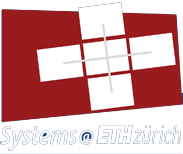Publication
Systems Group Master's Thesis, no. ETH Zürich; Department of Computer Science, January 2004
Supervised by: Prof. Gustavo Alonso
Supervised by: Prof. Gustavo Alonso
The evolution of the PDAs in the past years is comparable to the evolution of
PCs. They evolved from small pocket sized organizers to multipurpose devices.
Most of the available applications provide functionality that can not be changed
at runtime or that can be used only in one particular environment. If we assume
that users often change their environment, such applications would need to be
adapted. By using a component infrastructure as the basis for adaptation we
are able to add and remove new behavior as components without interfering the
user.
An important characteristic of computer networks is that they may be het-
erogeneous. For example, a wireless ad-hoc network might include Linux lap-
tops, Linux PDAs and PocketPC PDAs. By providing a heterogeneous environ-
ment cross-platform interaction can be supported.
In this master thesis we present an implementation of a component container
for pocket devices, particulary for devices that run on Microsoft's PocketPC
platform (e.g. HP iPAQ 5550) which comes with the .NET Compact Framework.
The container allows components to be inserted into the device where they are
started and stopped in an ad-hoc manner. This enables devices entering a new
unknown environment to be adapted to the environment's common components.
To accomplish this requirement a messaging component was migrated from a
java infrastructure supporting two di®erent communication protocols: TCP and
UDP.
@mastersthesis{abc,
abstract = {The evolution of the PDAs in the past years is comparable to the evolution of
PCs. They evolved from small pocket sized organizers to multipurpose devices.
Most of the available applications provide functionality that can not be changed
at runtime or that can be used only in one particular environment. If we assume
that users often change their environment, such applications would need to be
adapted. By using a component infrastructure as the basis for adaptation we
are able to add and remove new behavior as components without interfering the
user.
An important characteristic of computer networks is that they may be het-
erogeneous. For example, a wireless ad-hoc network might include Linux lap-
tops, Linux PDAs and PocketPC PDAs. By providing a heterogeneous environ-
ment cross-platform interaction can be supported.
In this master thesis we present an implementation of a component container
for pocket devices, particulary for devices that run on Microsoft{\textquoteright}s PocketPC
platform (e.g. HP iPAQ 5550) which comes with the .NET Compact Framework.
The container allows components to be inserted into the device where they are
started and stopped in an ad-hoc manner. This enables devices entering a new
unknown environment to be adapted to the environment{\textquoteright}s common components.
To accomplish this requirement a messaging component was migrated from a
java infrastructure supporting two di{\textregistered}erent communication protocols: TCP and
UDP.},
author = {Slavisa Maslic},
school = {ETH Z{\"u}rich},
title = {NADABS A Component Container for the .NET (Compact) Framework},
year = {2004}
}

